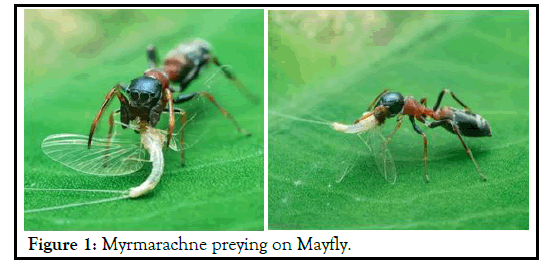Entomology, Ornithology & Herpetology: Current Research
Open Access
ISSN: 2161-0983
ISSN: 2161-0983
Short Communication - (2023)Volume 12, Issue 3
Predator prey interactions play a central role in the behavior, ecology and population biology of most taxa and are critical in community dynamics. Competition and predation are the most heavily investigated species interactions in ecology, dominating studies of species diversity maintenance. Predation has been implicated as a major selective force in the evolution of several morphological and behavioral characteristics of animals. Here in, we document a Myrmarachne sps. preying upon a mayfly. This is a precise documentation of the observation and importance of interaction between the two above mentioned species in a terrestrial ecosystem.
Prey-predator interactions; Invertebrate competition; Terrestrial ecosystem; Mimicry; Aquatic insect
Invertebrate predators play an important role in the ecosystem. Predation is an interaction during which an organism kills and feeds on another organism. It is one of the key factors governing patterns in natural systems. There are four commonly recognized types of predation: (1) Carnivory, (2) Herbivory, (3) Parasitism and (4) Mutualism. Predators can often play an important role in regulating the distribution and population dynamics of their natural prey. Predator prey interactions of terrestrial invertebrates are determined by predator body size and species identity. Although, almost all prey lives in communities with many predator species most studies of predation have, until recently, examined only one predator species or have considered different predators only one at a time. A series of recent papers, however, has demonstrated that multiple predators often have emergent impacts on prey; that is; multiple predators have effects that cannot be predicted simply by summing the effects of single predator types. Vertebrates are the top predators in many systems, but large invertebrates such as spiders, mantids, and centipedes are also important predators of various vertebrate and invertebrate groups thereby playing an important role in shaping the population of various taxa [1-3].
The jumping spider Myrmarachne plataleoides is a wellknown mimic of the weaver ant Oecophylla smaragdina Fabricius 1775 (also known as the Green Tree Ant, the Kerengga or the Red Ant), widely distributed in tropical south and southeast, (Figure 1) and is known to feed on smaller spiders. Across this range the two species are invariably found in close association on plants that are overrun by O. smaragdina. M. plataleoides has recently been placed in the plataleoides group, a clade within the large genus Myrmarachne. Although, the association with Oecophylla may represent an obligate relationship for M. plataleoides, these ants also represent a continuous danger [4].
Mayfly is aquatic insects belonging to the order Ephemeroptera distributed all over the world in clean freshwater habitats except Antarctica. The status of many species of mayflies is unknown because they are known from only the original collection data. Mayflies exhibit a number of ancestral traits that were probably present in the first flying insects, such as long tails and wings that do not fold flat over the abdomen [5].

Figure 1: Myrmarachne preying on Mayfly.
On 20th August 2022 (20° 39' 52.5'' N, 72° 57' 53.6'' E) we observed a Myrmarachne sps. Of about 3 cm length preying upon a mayfly of about 1cm in size belonging to the order Ephemeroptera. This is a unique observation wherein a prey-predator relation amongst two invertebrates is observed and documented from Kundi village in Gujarat, India [6,7].
Predator-prey models are arguably the building blocks of the bioand ecosystems as biomasses are grown out of their resource masses. Species compete, evolve, and disperse simply for the purpose of seeking resources to sustain their struggle for their very existence they deal with the general loss-win interactions and hence may have applications outside of ecosystems. When seemingly competitive interactions are carefully examined, they are often in fact some forms of predator-prey interaction in disguise. This is a rare documentation of the significant interaction between two unique species in the ecosystem.
The authors declare no conflict of interest during the preparation of this article.
We are thankful to earth crusaders organisation for their social awareness on wildlife from grassroot level and helping in drafting of this manuscript.
Citation: Patel A, Samal A, Pandey S (2023) The Jumping Ant Spider Myrmarachne Preying upon a Mayfly in Kundi Village, Gujarat, India. Entomol Ornithol Herpetol. 12:314.
Received: 08-May-2023, Manuscript No. EOHCR-22-19118; Editor assigned: 10-May-2023, Pre QC No. EOHCR-22-19118 (PQ); Reviewed: 24-May-2023, QC No. EOHCR-22-19118; Revised: 31-May-2023, Manuscript No. EOHCR-22-19118 (R); Published: 07-Jun-2023 , DOI: 10.35248/2475-7586.23.12.314
Copyright: © 2023 Patel A, et al. This is an open-access article distributed under the terms of the Creative Commons Attribution License, which permits unrestricted use, distribution, and reproduction in any medium, provided the original author and source are credited.